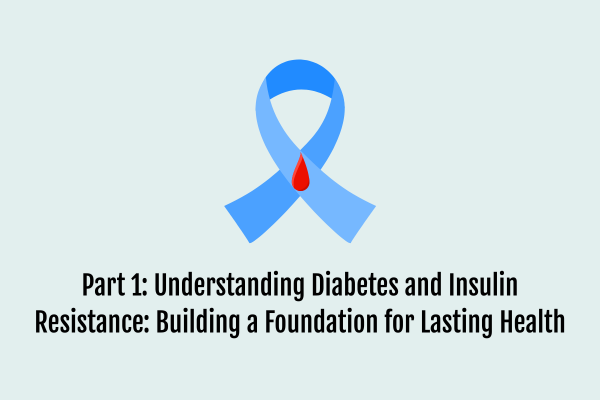Understanding Diabetes and Insulin Resistance: Building a Foundation for Lasting Health
Written by: Sophia Schweiger
Reviewed by: Andrew Wade, MS, RDN, LDN, CSSD
November is National Diabetes Awareness Month. It is a time to bring attention to how nutrition and lifestyle play a vital role in blood sugar balance and metabolic health. Learn what insulin resistance is, how to recognize early signs, and ways to support long-term prevention through personalized nutrition and healthy eating.
Diabetes affects millions of Americans, but its story begins long before diagnosis. For many, the root cause lies in insulin resistance—a metabolic shift that can quietly progress for years before symptoms appear. Understanding this process is one of the most empowering steps toward prevention and sustainable wellness.
What Is Insulin?
Insulin is a hormone released by the pancreas that helps transport nutrients, especially glucose, from your bloodstream into your cells. Think of it as your body’s messenger that signals, “Food is coming!” Once insulin delivers this message, the body pauses fat burning and shifts into energy storage mode.
In a healthy system, insulin rises after meals, helps shuttle nutrients where they’re needed, and returns to baseline within a few hours. This rhythm keeps blood sugar stable and energy steady.
Problems begin when insulin remains elevated too often. This can be a result of frequent eating, high stress levels, or disrupted sleep. When the body constantly hears “Food is coming!”, it becomes less responsive to insulin’s signals, leading to insulin resistance.
Over time, this state can make it harder for the body to use fat for energy, leading to metabolic slowdown, fatigue, and eventually Type 2 Diabetes Mellitus.
Recognizing Early Signs of Insulin Resistance
Insulin resistance doesn’t just appear overnight, but it builds gradually. The earlier it’s recognized, the easier it is to reverse. Common early indicators may include:
- Mid-day energy crashes or post-meal fatigue
- Cravings for sweets or carbohydrates after eating
- Difficulty losing weight despite exercise and dieting interventions
- Increased hunger or “snackiness” throughout the day
- Lab work showing elevated fasting insulin levels (above 10 μU/mL)
A fasting insulin test—measured after an overnight fast—can help reveal how well your body handles glucose between meals.
- 4–8 μU/mL: This reflects optimal function, with insulin rising and returning to baseline as it should.
- 10 μU/mL: Still normal, but worth monitoring for dietary or stress-related changes.
- 12–14 μU/mL: A sign to reassess eating patterns, meal frequency, and other early indicators.
- 20 μU/mL or higher: Indicates insulin resistance and the need for intervention.
Nutrition and Lifestyle Steps to Support Insulin Sensitivity
Restoring balance often starts with small, intentional adjustments that align with your body’s natural rhythm:
- Space your meals: Aim for at least 3 hours between meals or snacks to let insulin return to baseline.
- Avoid late-night eating: Ideally stop eating 2 hours before bed to give your body time to rest and reset before sleep.
- Build balanced plates: Prioritize protein, fiber, and healthy fats for steady energy.
- Move throughout the day: Even short walks improve glucose utilization.
- Manage stress: Chronic stress keeps insulin levels elevated, so recovery practices like journaling, deep breathing, or stretching matters.
At Case Specific Nutrition, our dietitians focus on individualized nutrition, helping clients build meal plans and meal prep strategies tailored to their metabolism, lifestyle, and goals. This personalized approach not only improves insulin sensitivity but also promotes sustainable healthy eating habits that last.
A Note on Type 1 and Type 2 Diabetes
While Type 1 Diabetes results from an autoimmune response that stops the pancreas from making insulin, Type 2 Diabetes develops when the body becomes resistant to insulin’s effects over time. Both conditions require careful management, but insulin resistance is unique in that it can often be prevented—and sometimes reversed—through lifestyle interventions guided by a registered dietitian.
Taking a Proactive Approach
Monitoring fasting insulin, creating balanced meal patterns, and managing stress are foundational tools for protecting metabolic health. The key is consistency, not perfection. When you understand how insulin functions, you can make informed choices that support energy, hormone balance, and long-term vitality.
Whether you’ve been diagnosed with type 2 diabetes, have risk factors that increase your chances of developing it, or simply want to optimize your health, Case Specific offers fasted insulin testing as part of its Proactive Health Blood Panel, which includes up to 80 different biomarkers. From there, you can work one-on-one with a dietitian to review your results and use them to guide your care, creating a personalized nutrition plan that aligns with your goals.
Stay tuned for Part 2
Our series continues as we explore the long-term benefits of maintaining insulin sensitivity, including more stable energy, improved hormone health, and enhanced overall wellness and performance.
If you’re looking to take the next step, reach out to scheduling@casespecificnutrition.com to connect with a Case Specific Dietitian. Our team provides individualized nutrition care across the Greater Pittsburgh area, as well as in Erie, Raleigh, and Tampa.
Disclaimer: The information provided in this blog is for educational purposes only and is not intended to diagnose, treat, cure, or prevent any medical condition. This content is not medical advice and should not be used as a substitute for professional medical care. If you have any health concerns or medical conditions, please consult with a qualified healthcare provider before making any changes to your diet or lifestyle.




.webp)

